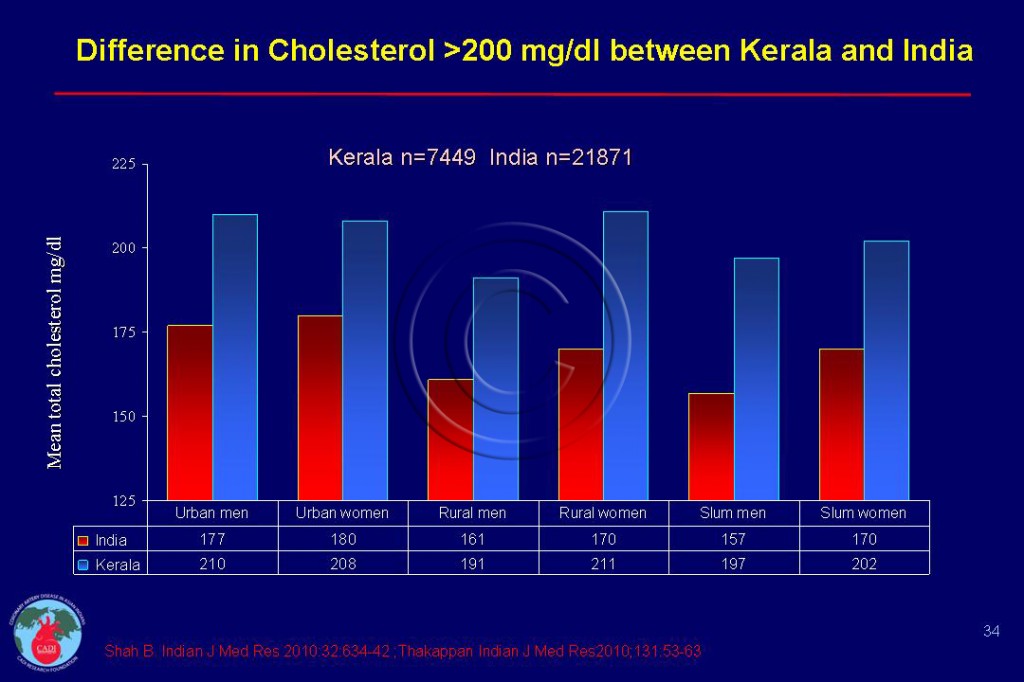Kerala Paradox
- Kerala has high literacy, high life expectancy and other indicators of socioeconomic progress including access to state of the art medical care for those who can afford it. One would expect a lower prevalence of heart disease and diabetes. Kerala Paradox refers to the unexpectedly and paradoxically high prevalence of lifestyle diseases ─ heart disease, diabetes, high blood pressure, and obesity resulting in very high mortality and morbidity from CAD (coronary artery disease) (see Kerala Heart Disease).
- Prevalence of many risk factors are nearly as high in rural areas with rural Keralans having paradoxically higher rates of diabetes than urban dwellers.1, 2 In one large study the prevalence of diabetes was 19% in rural men and 22% in rural women compared to 12% in urban men and 17% in urban women.1
- The prevalence of risk factors is high even in rural Kerala: diabetes 20%, high blood pressure 42%, high cholesterol (>200mg/dl) 72%, smoking (42% in men), obesity (body mass index >25) 40%, physical inactivity 41%, and alcohol consumption 13%.1, 3-5 However, the alcohol may be substantially higher and involves mostly binge drinking in men. The prevalence of risk factors are markedly higher in Kerala than the rest of India especially rural Kerala (Figure 033).1, 2
- The dramatic increase in premature CAD in Kerala is due to a corresponding increase in the modifiable risk factors related to lifestyle at a young age ─ many of which are unrecognized, untreated and uncontrolled despite the wealth of knowledge and the availability of safe and effective medications at a reasonable cost.6-9 The contributing factors include unhealthy diet, sedentary life, high consumption of alcohol, lack of physical activity, air-pollution, along with very high intake of saturated fat ─a cultural norm dating back to several millenniums.7
- Keralans have the highest cholesterol level in India that ranges from 197 to 229mg/dl compared to 157 to 180mg/dl nationally (Figure 034).1, 2 Cholesterol level in Kerala is approximately 30 to 40mg/dl higher than the national average in India, as well as in the US.1, 2, 5 High cholesterol level (>240 mg/dL) was found in 32% of subjects in Kerala vs. 15% in the US, where the cholesterol level has decreased to 199 mg/dl as a result of national efforts.1, 2, 5
- Total fat intake in Kerala is 30% of the energy with 70% of that (20% of daily energy) coming from saturated fat. Generous portions of coconut meat, milk and oil is used for preparing virtually every dishes including vegetables, fish and even meat and bread (Palappam, Vattayappam).3, 4
- Coconut is used throughout India as God’s food (offering to God) but as a universal ingredient for cooking in Kerala. Total fat intake in Kerala is 30% of the energy with 70% of that (20% of daily energy) coming from saturated fat.
- Special efforts are needed to educate the medical community and the general public about the culturally relevant ways of reducing energy from saturated fat in the form of palm oil, coconut oil, coconut meat, coconut milk, as well as full-fat dairy products to bring cholesterol levels at least to that of the remainder of India. See Indian Diet, Saturated fat, Trans fat and Contaminated Vegetarianism.
Sources
1. Thankappan K R, Shah B, Mathur P, et al. Risk factor profile for chronic non-communicable diseases: results of a community-based study in Kerala, India. Indian J Med Res. Jan 2010;131:53-63.
2. Shah B, Mathur P. Surveillance of cardiovascular disease risk factors in India: the need & scope. Indian J Med Res. Nov 2010;132(5):634-642.
3. Soman C. R, Kutty VR, Safraj S, Vijayakumar K, Rajamohanan K, Ajayan K. All-Cause Mortality and Cardiovascular Mortality in Kerala State of India: Results From a 5-Year Follow-up of 161 942 Rural Community Dwelling Adults. Asia Pac J Public Health. May 10 2010.
4. Soman CR, Shahulhameed S, Ramankutty V, et al. Cohort Profile: The PROLIFE study in Kerala, India. Int J Epidemiol. Sep 8 2009.
5. Joseph A, Kutty VR, Soman CR. High risk for coronary heart disease in Thiruvananthapuram City: A study of serum lipids and other risk factors. Indian Heart J. 2000;52(1):29-35.
6. Gupta R, Misra A, Pais P, Rastogi P, Gupta VP. Correlation of regional cardiovascular disease mortality in India with lifestyle and nutritional factors. Int J Cardiol. Apr 14 2006;108(3):291-300.
7. Sugathan TN, Soman CR, Sankaranarayanan K. Behavioural risk factors for non communicable diseases among adults in Kerala, India. Indian J Med Res. Jun 2008;127(6):555-563.
8. Kaur P, Rao T. Prevalence of cardiovacular trisk factors in an urban industrial population in South india. JAPI. 2007;55:771-776.
9. Mohan V, Deepa M, Farooq S, Prabhakaran D, Reddy KS. Surveillance for risk factors of cardiovascular disease among an industrial population in southern India. Natl Med J India. Jan-Feb 2008;21(1):8-13.



